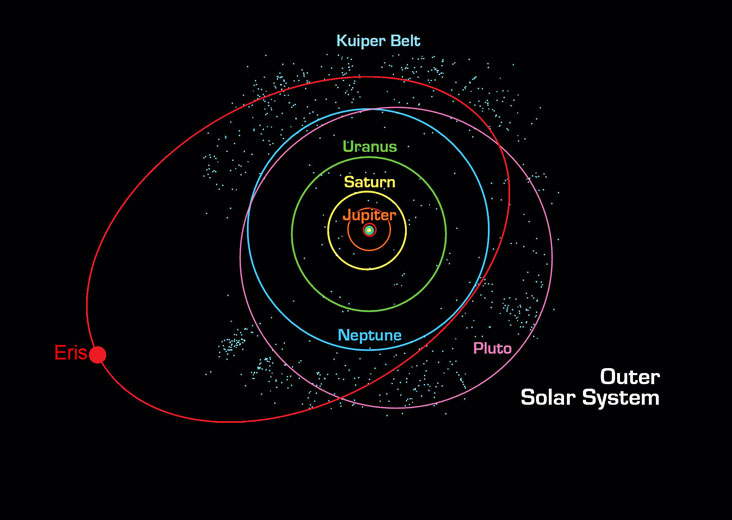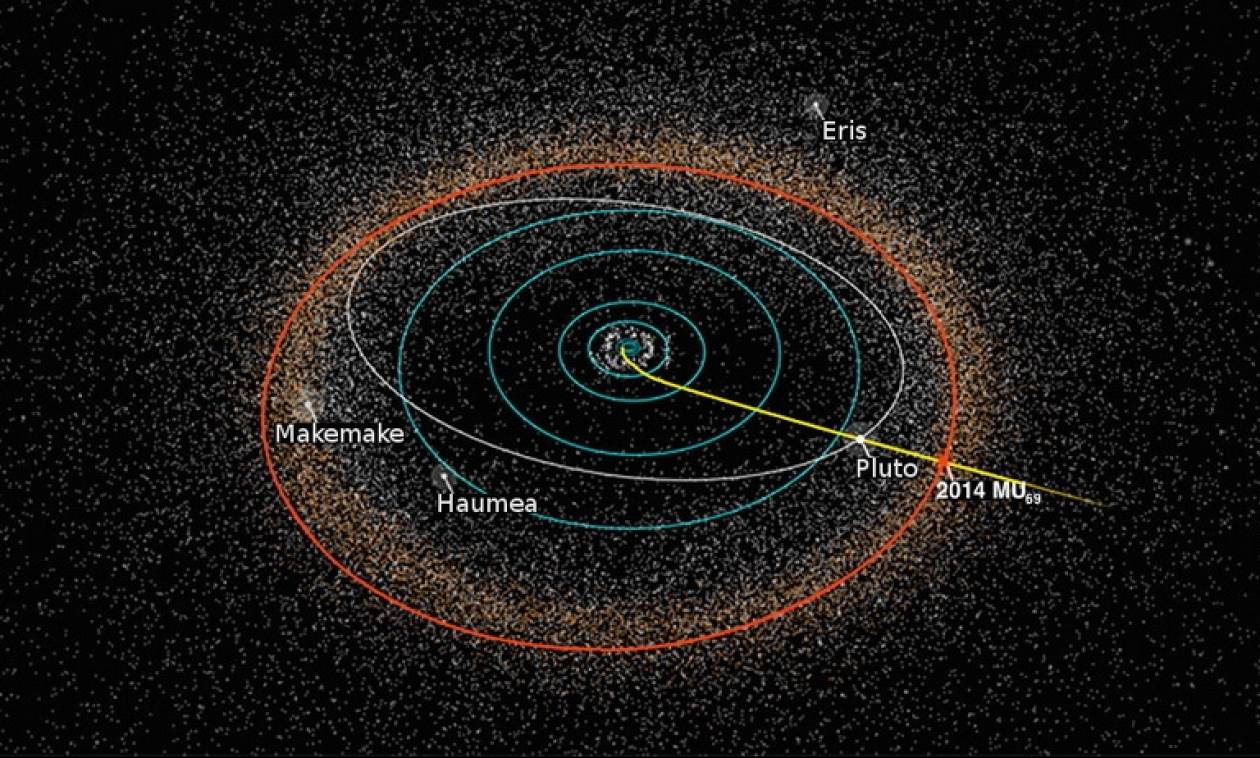How did it all start?
The Sun is the star at the center of the solar system - a sphere of hot plasma that is
But experts say that in about five billion years, the star will run out of energy and radically change the solar system.
Researchers believe that when the sun begins to rise sharply, its outer layers will expand until the star engulfs the planets, including the Earth.
But the chief investigator of NASA's Newhorizons, PhD Alan Stern discovered that while it can kill any life on Earth, it can also create habitable worlds in the coldest corners of space.
How will the Sun and Earth die?
Now the Sun is a very stable star withhydrogen, which undergoes nuclear fusion, turning into helium and energy. The energy leaking from the core to the upper layers of the star maintains a stable state of the Sun for more than four billion years.
But over time, helium accumulates in the core.Its reactions require more pressure and higher temperature, so now helium is inert. It just sits in the core, slowly heating up. In about 6 billion years, the Sun will run out of hydrogen in its core, it will shrink and heat up to extreme temperatures. Eventually, after a few hundred million years, conditions in the Sun's core will become so dire that helium will begin to melt into carbon and oxygen. They will accumulate in the core, generating enormous amounts of energy.
All this happens deep in the core of the Sun.The outer layers react to this slowly, but they do. When hydrogen shell fusion begins, the outer layers swell, turning the Sun into a red giant.
 The size of the Sun now (1.4 million km)compared to when it became a red giant about 7 billion years later. 1 a.u. — this is the distance from the Earth to the Sun now, 150 million km. Credit: Una Räisänen.
The size of the Sun now (1.4 million km)compared to when it became a red giant about 7 billion years later. 1 a.u. — this is the distance from the Earth to the Sun now, 150 million km. Credit: Una Räisänen.
When the Sun becomes a red giant, it becomeslarge enough to absorb Mercury and Venus. They will literally exist inside the Sun for some time. Ultimately, these planets will completely evaporate.
The fate of the Earth is not so clear.The subatomic particle wind, like the solar wind is now, will become much denser. The sun will lose enough mass to cause its gravity to weaken, which means that the orbits of the planets will expand. The problem is that the Earth is pretty much on the border separating its absorption by the red giant Sun and far enough to avoid this fate. It depends on detailed physics, for example how much mass the Sun will lose. In any case, the conditions on the planet will become unbearable.
Where do earthlings escape?
Early 2020 PhD Alan Stern, ScientistNASA, best known as the principal investigator of the New Horizons mission to study Pluto and the Kuiper Belt, detailed the fate of the Earth after the Sun becomes a red giant.
“At the end of the Sun’s life — in the red giant phase, the Kuiper Belt area will become a metaphorical Miami Beach.”
Dr. Stern believes that any remaining peoplecould find refuge on Pluto and other distant dwarf planets in the Kuiper Belt, a region beyond Neptune filled with icy space rocks. As the Sun expands, conditions on these worlds will change dramatically and become more suitable.
Today dwarf planets like Plutocontain a lot of water ice and complex organic materials, and some of them have oceans under the surface. But the surface temperature of these extraterrestrial bodies is hundreds of degrees below zero.
However, when the Sun becomes a red giant, Pluto's surface temperature will be about the same as the average temperatures on the Earth's surface now.
Another study published in the journalAstrobiology in 2003, Stern assessed the prospects for life in the outer solar system after a star enters its final stage of life. And three years later he headed the command of an interplanetary space mission. The probe sent to Pluto as part of the New Frontiers program («New Horizons») is aimed at deepening our understanding of the solar system.
What's on the edge of the solar system?
Beyond the gas giant Neptune is an areaspace filled with icy bodies. This cold space, known as the Kuiper Belt, contains trillions of objects — remnants of the early solar system.
 The Kuiper Belt is shown beyond the orbit of Neptune. One of its inhabitants is Eris, which is in a highly inclined elliptical orbit. (Image courtesy of NASA)
The Kuiper Belt is shown beyond the orbit of Neptune. One of its inhabitants is Eris, which is in a highly inclined elliptical orbit. (Image courtesy of NASA)
In 1943, astronomer Kenneth Edgeworth suggestedthat comets and larger bodies could exist outside Neptune. And in 1951, astronomer Gerard Kuiper predicted the existence of a belt of icy objects at the far edge of the solar system. Today the rings predicted by this pair are known as the Kuiper belt or Edgeworth-Kuiper belt.
Despite its enormous size, the Kuiper beltwas not discovered until 1992 by astronomers Dave Jewitt and Jane Luu. According to NASA, the pair of scientists "have been persistently scanning the sky for faint objects beyond the orbit of Neptune" since 1987, which has been cataloged as "1992 QB1"
Since then, astronomers have found severalintriguing Kuiper belt objects and potential planets in the region. NASA's New Horizons mission continues to uncover previously hidden planets and objects, helping scientists learn more about this unique relic of the solar system.
What is the Kuiper Belt?
Like the asteroid belt, the Kuiper belt isa region left over from the early history of the solar system. Like the asteroid belt, it was also formed by a giant planet, although it is more of a thick disc (like a donut) than a thin belt.
 The artist's painting depicts a distantthe dwarf planet Eris in the distance with its moon Dismonia in the foreground. Both call the Kuiper Belt "home." New observations show that Eris is smaller than previously thought and almost the same size as Pluto.
The artist's painting depicts a distantthe dwarf planet Eris in the distance with its moon Dismonia in the foreground. Both call the Kuiper Belt "home." New observations show that Eris is smaller than previously thought and almost the same size as Pluto.
(Image: © ESO / L. Calçada)
When the solar system was formed, a largesome of the gas, dust and rocks come together to form the sun and planets. Then the planets carried most of the remaining debris to the Sun or outside the Solar System. But objects at the edge of the solar system were far enough away to escape the gravitational pull of much larger planets like Jupiter, and so they managed to stay in place as they slowly orbited the sun. The Kuiper Belt and its compatriot, the more distant and spherical Oort Cloud, contain remnants left over from the beginning of the creation of the solar system, can provide valuable information about its birth.
According to the Nice model, one of the proposedmodels of the formation of the solar system — The Kuiper Belt may have formed closer to the Sun, near where Neptune now orbits. In this model, the planets engaged in a complex dance in which Neptune and Uranus switched places and moved outward, away from the Sun. As the planets moved away from the Sun, their gravity could carry many Kuiper Belt objects with them, carrying tiny objects ahead as the ice giants migrated. As a result, many Kuiper belt objects were moved from the region in which they were created to the cooler part of the solar system.
Most populous part of the Kuiper beltis 42-48 times larger than the Earth from the Sun. The orbit of objects in this area remains largely stable, although sometimes the course of some objects changes slightly when they drift too close to Neptune.
Scientists have calculated that thousands of bodies with a diameter of more than100 km (62 mi) orbit the Sun within this belt, along with trillions of smaller objects, many of which are short-period comets. The region also contains several dwarf planets — round worlds, too large to be considered asteroids, but too small to be considered planets.
Kuiper Belt Objects

Pluto— the largest known icedwarf planets. Pluto was the first true Kuiper belt object (KBO) observed, although scientists at the time did not recognize it as such until other KBO objects were discovered. When Jewitt and Luu discovered the Kuiper Belt, astronomers soon saw that the region beyond Neptune was full of icy rocks and tiny worlds.
Sedna- the most massive and second largest knowna dwarf planet in our solar system, KBO, about three-quarters the size of Pluto, was discovered in 2004. It is so far from the Sun that it takes about 10,500 years to complete one revolution. Sedna is about 1,770 km wide and orbits the Sun in an eccentric orbit ranging from 12.9 to 135 billion km.
In July 2005, astronomers discoveredEridu, a KBO that is slightly smaller than Pluto.Eris orbits the Sun approximately once every 580 years, traveling nearly 100 times further from the Sun than Earth. Its discovery showed some astronomers the problem of classifying Pluto as a full-blown planet. According to the International Astronomical Union (IAU) definition from 2006, a planet must be large enough to clear its surroundings of debris. Pluto and Eris, surrounded by the Kuiper belt, clearly could not do this. As a result, in 2006, Pluto, Eris and the largest asteroid, Ceres, were reclassified as dwarf planets by the IAU. Two more dwarf planetsHaumeaAndMakemake, were discovered in the Kuiper belt in 2008.
Haumea (780 km) is the fastest rotating dwarf planet with a ring around it. Makemake (715 km) is probably a dwarf planet with its own satellite.
Astronomers are now redefining Haumea's status asdwarf planet. In 2017, when the object passed between the Earth and a bright star, scientists realized that it was more elongated than round. According to the IAS definition, circumference is one of the criteria for a dwarf planet. The elongated shape of Haumea may have been the result of its rapid rotation; a day at the facility lasts only about four hours.
The Kuiper Belt is truly a boundary in space — it's a place that scientists are just beginning to explore. Perhaps in billions of years it will become a new home for earthlings.
Read more
The Ministry of Health of Argentina disclosed data on side effects in those who received "Sputnik V"
Platypus turned out to be a genetic mixture of mammals, birds and reptiles
Abortion and science: what will happen to the children who will give birth
The Nice model is a scenario for the dynamic development of the solar system. Its development was started at the Observatory of the Côte d'Azur in Nice, France.